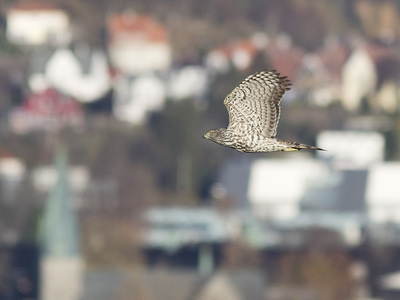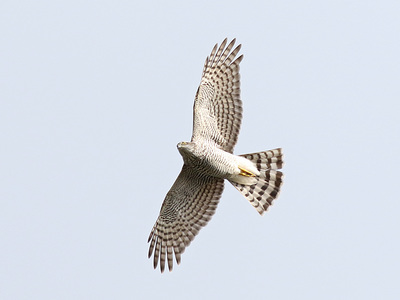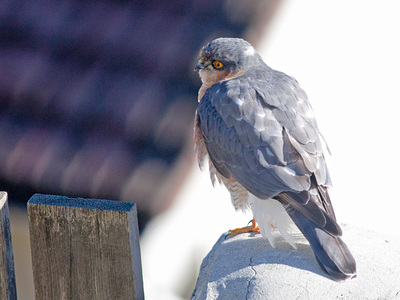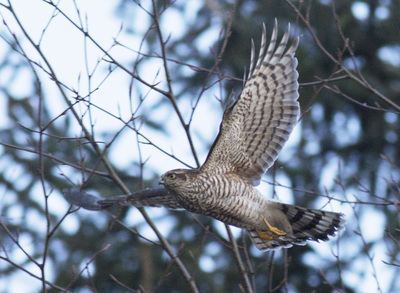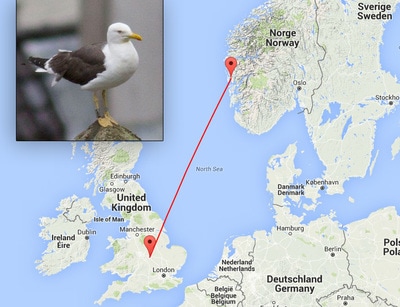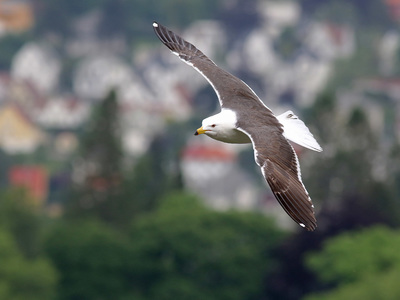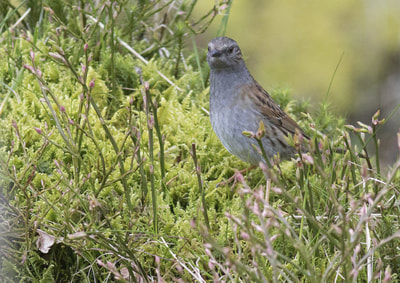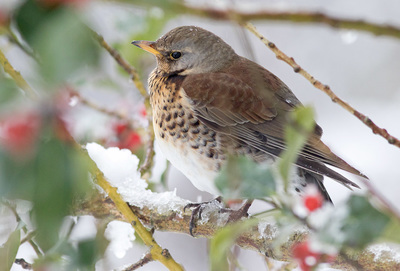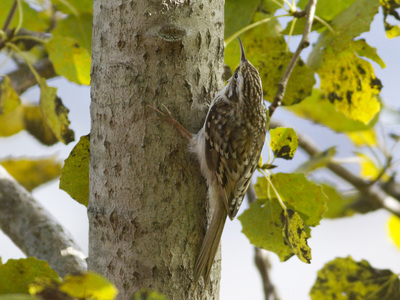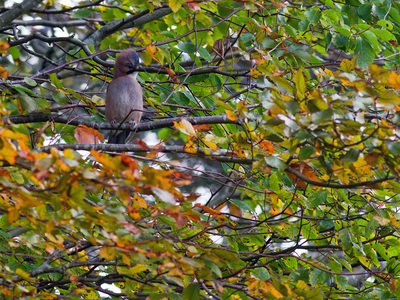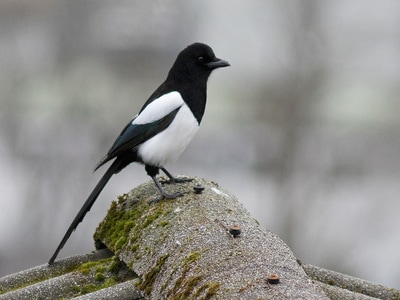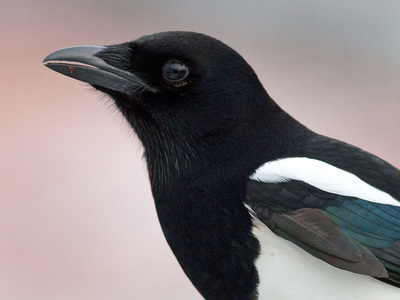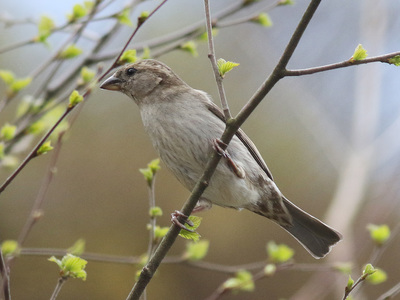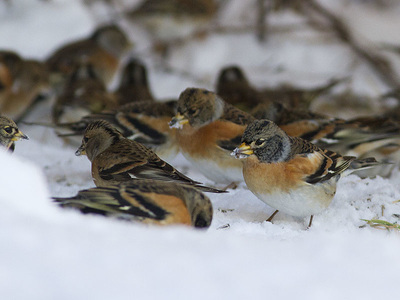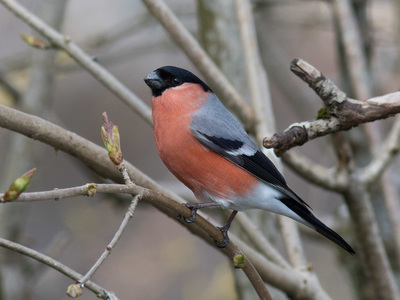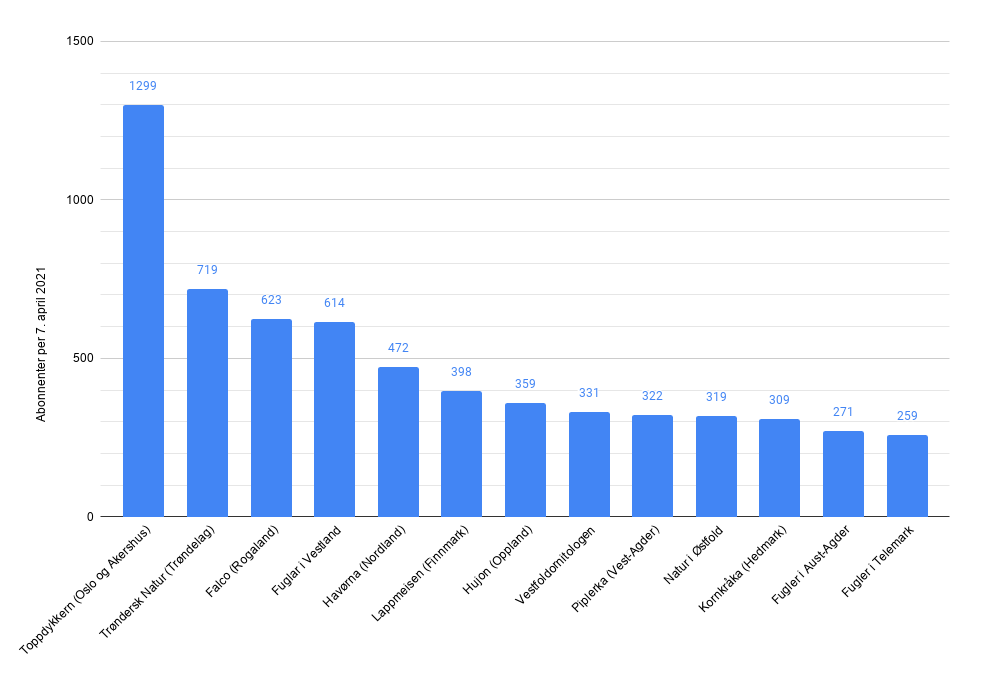My Garden birds
WHOOPER SWAN Cygnus cygnus
No: Sangsvane Status: Scarce. Flying by or resting in lake Tveitevann during autumn and winter. MUTE SWAN Cygnus olor
No: Knoppsvane Status: Regular throughout the year, both flying by and resting at lake Tveitevann. BEAN GOOSE Anser fabalis
No: Sædgås Status: A single bird flew past the garden 24 January 2014. It was later refound about 20 kilometers away and was identified as a Tundra Bean Goose, Anser fabalis rossicus. PINK-FOOTED GOOSE Anser brachyrhynchus
No: Kortnebbgås Status: 16 birds migrating south on 9 October 2015 is the only record. GREYLAG GOOSE Anser anser
No: Grågås Status: Only recorded once during spring migration, when 12 birds flew north on 7 April 2015. More records during autumn, and all are during August and early September. The largest flock was 120 birds flying south in the evening 3 August 2014. Records: observations | histogram CANADA GOOSE Branta canadensis
No: Kanadagås Status: Recorded once, when 14 birds flew south past the garden 8 August 2014. COMMON SHELDUCK Tadorna tadorna
No: Gravand Status: Recorded once, when a young bird migrated south over Mount Landåsfjellet together with 64 Greylag Geese 22 August 2017. EURASIAN WIGEON Anas penelope
No: Brunnakke Status: Not occuring near my garden, but birds in lake Tveitevann and Solheimsvann are normally (when not frozen) rather easily seen through a telescope during the non breeding season. MALLARD Anas platyrhynchos
No: Stokkand Status: Birds in lake Tveitevann and Solheimsvann are (when not frozen) rather easily seen through a telescope throughout the year. TUFTED DUCK Aythya fuligula
No: Toppand Status: Not occuring near my garden, but birds in lake Tveitevann and Solheimsvann are normally (when not frozen) rather easily seen through a telescope during the non breeding season. GREATER SCAUP Aythya marila
No: Bergand Status: One record. A 2cy male was wintering in lake Tveitevatn during the late winter in 2016, and was seen on one occasion from the garden 3 April 2016. GOOSANDER Mergus merganser
No: Laksand Status: One record. A male in Lake Tveitevann 18 January 2015. BLACK GROUSE Tetrao tetrix
No: Orrfugl Status: Despite lekking not far away (but in a more alpine habitat) only one bird has been observed. A female flew by the garden on the afternoon 21 April 2016. GREY HERON Ardea cinerea
No: Gråhegre Status: Fly-by's accidental year round. Records: observations | histogram WHITE-TAILED EAGLE Haliaeetus albicilla
No: Havørn Status: Scarce. WESTERN MARSH HARRIER Circus aeruginosus
No: Sivhauk Status: A juvenile or female migrated south near Mount Ulriken 22 August 2016. NORTHERN GOSHAWK Accipiter gentilis
No: Hønsehauk Status: Scarce. Observed in the period from mid August to mid April. Records: observations | histogram EURASIAN SPARROWHAWK Accipiter nisus
No: Spurvehauk Status: Scarce throughout the year. Most records during winter. COMMON BUZZARD Buteo buteo
No: Musvåk Status: Rare. Five records from 2016-2019. Records: observations | histogram ROUGH-LEGGED BUZZARD Buteo lagopus
No: Fjellvåk Status: Scarce autumn (September) visitor. All records are of birds migrating or feeding on the "Ulriken ridge" on the eastern side of the Bergen valley. Records: observations | histogram OSPREY Pandion haliaetus
No: Fiskeørn Status: A bird migrating towards the north 11 May 2016 is the only record. A scarce species in Hordaland county, with less than five records a year. Records: observations | histogram COMMON KESTREL Falco tinnunculus
No: Tårnfalk Status: Mainly observed during autumn migration, from mid August until early November. Best day was 8 September 2016, when 32 birds were recorded when migration south. Five spring records. Records: observations | histogram PEREGRINE FALCON Falco peregrinus
No: Vandrefalk Status: Scarce. Mainly observed outside the breeding season. Records: observations | histogram EURASIAN COOT Fulica atra
No: Sothøne Status: Birds in lake Tveitevann and Solheimsvann are (when not frozen) rather easily seen through a telescope throughout the year. COMMON CRANE Grus grus
No: Trane Status: Rare. A single bird soared above Landåsfjellet 9 June 2015, and migrated towards the southeast. EURASIAN OYSTERCATCHER Haematopus ostralegus
No: Tjeld Status: One (or possibly two) pair are breeding on roofs at Mindemyren, and are seen or heard daily in the breeding season (early April to early September). No records outside this period. Records: observations | histogram EUROPEAN GOLDEN PLOVER Pluvialis apricaria
No: Heilo Status: Only recorded once in the period from 2013 until August 2020. Then several were recorded using NocMig. COMMON SANDPIPER Actitis hypoleucos
No: Strandsnipe Status: Scarce migrant during night, mainly in May or August. Records: observations | histogram COMMON GREENSHANK Tringa nebularia
No: Gluttsnipe Status: The only record was when a bird was heard during night (migrating) 5 August 2014. EURASIAN WOODCOCK Scolopax rusticola
No: Rugde Status: 3 records (incl. roding birds in April 2016 and 2017). Records: observations | histogram COMMON SNIPE Gallinago gallinago
No: Enkeltbekkasin Status: Rare. One record from early April 2016. Records: observations | histogram BLACK-HEADED GULL Larus ridibundus
No: Hettemåke Status: Scarce, only a handful records. COMMON GULL Larus canus
No: Fiskemåke Status: Common all year. 20+ pairs breed at Mindemyren, a location very well seen from the garden. During the non breeding season a few birds occasionally feed nearby, but most birds are seen as fly-by's, and at their all-year sites Lake Tveitevatn and Lake Solheimsvatn. LESSER BLACK-BACKED GULL Larus fuscus
No: Sildemåke Status: Observed in the period 10 March (2020) - 16 October (2018). 1-2 pairs breed at Mindemyren, but most birds are seen passing by in flight. EUROPEAN HERRING GULL Larus argentatus
No: Gråmåke Status: Common species flying by all year. ICELAND GULL Larus glaucoides
No: Grønlandsmåke Status: One record of a 1cy flying by on 4 December 2015. GREAT BLACK-BACKED GULL Larus marinus
No: Svartbak Status: Accidental in the non breeding season. ARCTIC TERN Sterna paradisaea
No: Rødnebbterne Status: Rare. A nocturnal migrating flock passed the garden 19 August 2020. The record below is done with a mobile telephone. FERAL PIGEON Columba livia var. domestica
No: Bydue Status: Scarce. Usually seen as fly-by's in the valley below. WOOD PIGEON Columba palumbus
No: Ringdue Status: Seen daily in the breeding and migration season. Variable winter occurence. Plentiful during the winter 2015-16. Highest number recorded was 260 birds flying by in the morning 5 December 2015. EURASIAN COLLARED DOVE Streptopelia decaocto
No: Tyrkerdue Status: Scarce. Only seen in/from the garden a few times, but singing birds can be heard during spring and summer. NORTHERN HAWK OWL Surnia ulula
No: Haukugle Status: Rare. Singles observed feeding at mount Landåsfjellet on 5 and 10 September 2016, and at mount Ulriken 9 November 2020. TAWNY OWL Strix aluco
No: Kattugle Status: Observed all year, but most records in autumn (August-November). Most records are of calling or singing birds. Listen to a calling bird 3 February 2018 here. LONG-EARED OWL Asio otus
No: Hornugle Status: Rare. One record (10 November 2015). COMMON SWIFT Apus apus
No: Tårnseiler Status: Irregular. Observed in the period 15 May (2015) to 8 September(2016). Highest counts were 32 birds feeding above the garden 17 August 2016, and 75 birds 22 August 2017. GREY-HEADED WOODPECKER Picus canus
No: Gråspett Status: Two records (7-8 December 2013 and 16 January 2016). GREAT SPOTTED WOODPECKER Dendrocopos major
No: Flaggspett Status: Rare, exept during irruptions (2013/14). LESSER SPOTTED WOODPECKER Dendrocopos minor
No: Dvergspett Status: Rare. One record (10 April 2016). BARN SWALLOW Hirundo rustica
No: Låvesvale Status: Accidental in the period from early May until mid September. The best day was 27 August 2017 when ten birds was seen from the garden. TREE PIPIT Anthus trivialis
No: Trepiplerke Status: Singing birds are heard from mid May and until late June. Birds on autumn migration passing in August and early September. The species has been observed in the period 10 May (2016) to 16 September (2016). MEADOW PIPIT Anthus pratensis
No: Heipiplerke Status: Not uncommon on passage in April and September. The species breed not far away, but on higher elevations than my garden. Random birds from this population are seen throughout the breeding season. Observed in the period from 27 March (2017) until 1 November (2016). GREY WAGTAIL Motacilla cinerea
No: Vintererle Status: Scarce. Mainly singles observed migrating past the garden in the period 14 September (2016) to 14 October (2017). WHITE WAGTAIL Motacilla alba
No: Linerle Status: Irregular visitor from early April until late September. Probably breeding in the neigbourhood. Most birds seen flying by or on migration. BOHEMIAN WAXWING Bombycilla garrulus
No: Sidensvans Status: Seven records in the autumn period 26 October to 15 December. Biggest party was 35 birds flying by 26 October 2015. WINTER WREN Troglodytes troglodytes
No: Gjerdesmett Status: Common throughout the year. DUNNOCK Prunella modularis
No: Jernspurv Status: Present through the breeding season, and during autumn migration (peaking from mid August until mid September). Observed in the period 30 March (2014) to 1 November (2016). EUROPEAN ROBIN Erithacus rubecula
No: Rødstrupe Status: Common all year. Maximum number recorded was 7 birds 10 October 2016. RING OUZEL Turdus torquatus
No: Ringtrost Status: One record. A juvenile bird smashed into my garden window, and died, 26 July 2015. This also was the first record for for the general area Minde. Ring Ouzels are rare to see at such low elevations in Bergen, but they breed in the treeline a kilometer or so behind my garden. COMMON BLACKBIRD Turdus merula
No: Svarttrost Status: Common all year. Up to 30 birds can pack themselves together at the garden feeder when the conditions are right (complete snow cover combined with me feeding them with oatmeal and apples). In spring at least five birds can be heard singing from the garden from April. FIELDFARE Turdus pilaris
No: Gråtrost Status: Common in autumn, scarce otherwise. SONG THRUSH Turdus philomelos
No: Måltrost Status: Regular in the breeding season and during autumn migration. Observed in the period 27 March (2017) until 23 October (2015). REDWING Turdus iliacus
No: Rødvingetrost Status: Despite breeding not far away, it has never been recorded in the breeding season, and it has never been heard singing from the garden. Observed in the period from mid August until late February. Most birds have been recorded during autumn migration, and numers peak in October. Scarce during winter. COMMON WHITETHROAT Sylvia communis
No: Tornsanger Status: One record; a singing bird heard behind the garden on 2 and 3 July 2015. GARDEN WARBLER Sylvia borin
No: Hagesanger Status: Only one record. A bird was seen feeding on Rowan berries 16 September 2014. EURASIAN BLACKCAP Sylvia atricapilla
No: Munk Status: Breeding birds are seen all through the breeding season (early May until primo October). Rare during winter. YELLOW-BROWED WARBLER Phylloscopus inornatus
No: Gulbrynsanger Status: Observed on eight dates in the period 17 September (2015) - 5 October (2016), involving at least 16 different birds. WOOD WARBLER Phylloscopus sibilatrix
No: Bøksanger Status: A single record, of a singing bird 11 June 2014. CHIFFCHAFF Phylloscopus collybita
No: Gransanger Status: Regular during the breeding season and on autumn migration. Observed in the period from 10 April (2016) to 25 October (2016). WILLOW WARBLER Phylloscopus trochilus
No: Løvsanger Status: Very common in the breeding season from early May until August. Only a few records in September, where the latest is 10 September 2014. GOLDCREST Regulus regulus
No: Fuglekonge Status: Common in the non breeding season. Scarce during summer, but singing birds can be heard from April until June. SPOTTED FLYCATCHER Muscicapa striata
No: Gråfluesnapper Status: A dozen records. Two from early June, and the rest from August. EUROPEAN PIED FLYCATCHER Ficedula hypoleuca
No: Svarthvit fluesnapper Status: Annual breeder. Earliest record is 11 May (2014) and the latest is 1 September (2014). LONG-TAILED TIT Aegithalos caudatus
No: Stjertmeis Status: Scarce. Mostly observed outside the breeding season, but in 2016 two adults were seen in mid May, and a juvenile bird 13 June. This might indicate that the species breeds nearby. An unprecedented influx during the autumn of 2016 resulted in almost daily observations from early September until November. BLUE TIT Cyanistes caeruleus
No: Blåmeis Status: Resident birds are common all through the year. Numbers peak a little in autumn when migrants pop by. Records: observations | histogram GREAT TIT Parus major
No: Kjøttmeis Status: Common all through the year. Mainly resident birds about, but during autumn "unlocal" parties pass by the garden now and then. COAL TIT Periparus ater
No: Svartmeis Status: Scarce. Breeding nearby. Can be seen all year, but always in low numbers (normally 1-2, max 4). MARSH TIT Poecile palustris
No: Løvmeis Status: Five records, including a couple long-stayers at the garden feeder. All records are in the non breeding season. WILLOW TIT Poecile montanus
No: Granmeis Status: Scarce, all seasons. EURASIAN NUTHATCH Sitta europaea
No: Spettmeis Status: Scarce, mainly seen in the non breeding season. EURASIAN TREECREEPER Certhia familiaris
No: Trekryper Status: Scarce. Mainly observed in autumn and winter. Recorded in the period from 15 August (2015) to 27 February (2018). In January 2018 I started rubbing unsalted fat on tree-trunks, and managed to attract two birds that came on daily visits the rest of the winter. EURASIAN JAY Garrulus glandarius
No: Nøtteskrike Status: Only a dozen observations. Probably breeding only a few kilometers away. EURASIAN MAGPIE Pica pica
No: Skjære Status: Resident birds that are common all through the year. Records: observations | histogram EURASIAN NUTCRACKER Nucifraga caryocatactes
No: Nøttekråke Status: Rare. Two records during the south Norwegian influx in early autumn 2016; singles on 5 and 8 September. Records: observations | histogram WESTERN JACKDAW Corvus monedula
No: Kaie Status: Present all year, but most visible outside the breeding season. A few pairs breed nearby. Biggest group seen was 18 birds together 8 February 2015. Records: observations | histogram CARRION CROW Corvus corone
No: Svartkråke Status: A bird flew south past the garden 5 October 2016. HOODED CROW Corvus cornix
No: Kråke Status: Common all year. RAVEN Corvus corax
No: Ravn Status: Accidental all year. STARLING Sturnus vulgaris
No: Stær Status: Accidental. Observed from mid March until mid November. HOUSE SPARROW Passer domesticus
No: Gråspurv Status: Common. Can be heard from the garden year round, and several pairs are breeding just 50 meters away. Not very common at the feeder during winter. During summer adults come to feed for insect larvaes, and when the chicks are fledged, they are feeding along with their parents for a while. When I am feeding with nuts, House Sparrows may be recorded with up to a dozen birds. When not feeding, they are not visiting the actual garden much. COMMON CHAFFINCH Fringilla coelebs
No: Bokfink Status: Common during the breeding season and autumn, scarce during winter. Highest number in one day was 5 April 2016, when at least 60 individuals were observed. Records: observations | histogram BRAMBLING Fringilla montifringilla
No: Bjørkefink Status: Irruptive, and may be numerous during the non breeding season. It is not a breeding species. Recorded in the period 16 September (2014) to 26 April (2016). Records: observations | histogram EUROPEAN GREENFINCH Carduelis chloris
No: Grønnfink Status: Present in low numbers year round. Probably breeding nearby. Highest count was 20 birds on the feeder 1 January 2014. Records: observations | histogram EUROPEAN GOLDFINCH Carduelis carduelis
No: Stillits Status: Rare. A single winter observation, and two records during autumn migration. Records: observations | histogram EURASIAN SISKIN Carduelis spinus
No: Grønnsisik Status: Common. Recorded all year. Records: observations | histogram COMMON LINNET Carduelis cannabina
No: Tornirisk Status: 2 records. Records: observations | histogram MEALY REDPOLL Carduelis flammea
No: Gråsisik Status: Occuring irruptive in the non breeding season. From totally absent, to very present. The best days have been during autumn migration, from late October to early November, when more than 200 birds have been recorded on migration on several occasions. LESSER REDPOLL Carduelis cabaret
No: Brunsisik Status: Quite similar status as the Common Redpoll (above), but in lower numbers. Generally scarce during winter, and seen in variable numers during the breeding season. ARCTIC REDPOLL Carduelis hornemanni
No: Polarsisik Status: One record; a single bird together with Mealy Redpolls on the feeder 18 March 2014. COMMON CROSSBILL Loxia curvirostra
No: Grankorsnebb Status: Accidental outside the breeding season. Records: observations | histogram EURASIAN BULLFINCH Pyrrhula pyrrhula
No: Dompap Status: An irruptive species that is mostly recorded during winter and spring. Seen in the period from mid October to early June. Probably breeding nearby. HAWFINCH Coccothraustes coccothraustes
No: Kjernebiter Status: Accidental YELLOWHAMMER Emberiza citrinella
No: Gulspurv Status: One record; 3 April 2015. REED BUNTING Emberiza schoeniclus
No: Sivspurv Status: A migrating bird 20 September 2016 and a bird that hung arond the feeder in the period from 22 November until 7 December 2019 are the only records. |
Goal: Reporting total checklists from as many days as possible to study the phenology and changing diversity of birds in suburban Bergen
Effort: Random obs during morning coffees, garden work and evening drinks Site: Minde in Bergen, western Norway - map Rules: Birds seen in or from the garden. Recent New garden species128. Firecrest (07-11-2022)
127. Cuckoo (21-05-2022) 126. Rook (24-11-2021) 125. Twite (13-09-2021) 124. Eurasian Curlew (09-09-2021*) 123. Yellow Wagtail (28-08-2021) 122. Ringed Plover (21-08-2020*) 121. Arctic Tern (19-08-2020) 120. Spotted Redshank (16-08-2020) 119. Common Redshank (13-08-2020) 118. Red-throated Diver (29-05-2020) 117. Pine Grosbeak (28-10-2019) 116. Bar-tailed Godwit (04-09-2018) 115. Green Sandpiper (12-08-2018) 114. Icterine Warbler (28-05-2018) 113. Parrot Crossbill (01-10-2017) 112. House Martin (25-08-2017) 111. Common Shelduck (22-08-2017) 110. Golden Eagle (22-08-2017) 109. Sand Martin (22-08-2017) 108. Common Goldeneye (24-01-2017) 107: White-fronted Goose (06-01-2017) 106. Carrion Crow (05-10-2016) 105. Rock Pipit (23-09-2016) 104. Reed Bunting (20-09-2016) 103. Grey Wagtail (14-09-2016) 102. Merlin (13-09-2016) 101. Common Buzzard (05-09-2016) 100. Northern Hawk Owl (05-09-2016) 99. Eurasian Nutcracker (05-09-2016) 98. Western Marsh Harrier (22-08-2016) 97. Ringtail Harrier (22-08-2016) 96. Eurasian Wryneck (02-06-2016) 95. Osprey (11-05-2016) 94. Black Grouse (21-04-2016) 93. Lesser Spotted Woodpecker (10-04-2016) 92. Greater Scaup (03-04-2016) 91. Common Snipe (29-03-2016) 90. European Goldfinch (04-02-2016) 89. Black-headed Gull (21-12-2015) 88. Iceland Gull (04-12-2015) 87. Long-eared Owl (10-11-2015) 86. Pink-footed Goose (09-10-2015) 85. Yellow-browed Warbler (17-09-2015) 84. Long-tailed Tit (12-09-2015) 83. Ring Ouzel (26-07-2015) 82. Common Whitethroat (02-07-2015) 81. Common Crane (09-06-2015) 80. Yellowhammer (03-04-2015) 79. White-tailed Eagle (31-01-2015) 78. Sparrowhawk (20-01-2015) 77. Goosander (18-01-2015) 76. Cormorant (11-01-2015) * NocMig Best day22 August 2017: 40 species, including microbirding rarities such as Sand Martin, Rough-legged Buzzard, Golden Eagle and Shelduck.
Most reported Species 20161. Great Tit
2. Wood Pigeon 3. Blackbird 4. Blue Tit 5. Hooded Crow 6. Black-billed Magpie 7. European Robin 8. Eurasian Siskin 9. Herring Gull 10. Common Gul Species per month |





